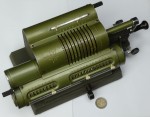
The Antares P4 is a pinwheel calculator from Italy. It has a 10-digit input without a display register. The carriage at the front holds a 13-digit register with an 8-digit counter to its left. Turning the crank on the right of the machine clockwise will add the input to the register, and turning it anti-clockwise subtracts the input from the register. Most of the controls are next to the crank to allow for easy one-handed operation. Below the crank handle are buttons that shift the carriage one step to the right or left. The carriage can also be shifted step-wise using the tab on the front of the machine, or moved any amount by pressing the button on the front. To the rear of the crank is a lever that resets the input to zero. The levers on the left and right ends of the carriage reset the counter and register to zero respectively.
The counter register has a carry mechanism. After the counter is cleared, the first turn of the crank will increment the counter, whether that turn is an addition or subtraction. After that, the counter direction is locked in so that it will count the net number of times the chosen operation is performed.
The serial number is 4/21051. It is not clear exactly when it was made, but probably around the mid 1950s. The carry mechanism of the counter works in exactly the same way as the carry mechanism of the main register. A drum is housed in an extension of the body just behind the counter, and the drum has a spiral arrangement of carry pins. When a digit overflows, a switch is pushed out, which deflect the carry pin on the drum leftwards causing it to increment the next number wheel.
The input clearing mechanism consists simply of a set of toothed sections that rotate to engage with teeth on the input discs, rotating them until a spot is reached without teeth. Note that there is no interlock between the input clearing and the crank, so if you do both at the same time you can lock up the machine and then you will have to open it to release the latch and allow the crank to reverse.
In 1940 Paolo Pozzi founded his company Organizzazione Pozzi S.p.A., in Milan. It supplied office machines, such as typewriters and calculators, not only by importing foreign machines including the Precisa adding machines, but also by manufacturing their own. These machines were given the brandname Antares, which is the name of the brightest star in the constellation Scorpio, and use a star-shaped logo.
In 1945 Paolo Pozzi co-founded the "Associazione Nazionale Commercianti Macchine e Forniture per Ufficio", or Comufficio, an association of Italian office machine and supplies companies. Pozzi was its first president until 1952.
In 1959 the company was renamed Antares S.p.A. While the company had offices and showrooms in Milan, the manufacturing was done about 25 kilometres to the North, in Calò. There are now few traces of the factory remaining in the village, with only the Antares Car Park still bearing the name.
At some point in the 1960s Antares stopped making their own machines. Antares typewriters were still being made, but they were essentially rebadged Olivettis (e.g. the Olivetti Dora). The same was true of the Antares calculators, such as the Antares Lei which was essentially the same as the Olivetti Summa 19 with a different case.
I have not found a complete list of pinwheel models anywhere, so I have had to
piece together the information below from various calculator sites and online
images of advertisements.
The first calculator model, the P1, was released in 1940 or 1941. It was improved
upon with the models P2 and then the P3. The latter had variants P6, P10, and P15
which were the same but with an input display register and/or a back transfer mechanism.
These were released no later than 1947. A large capacity model, the P30 was also made.
In about 1950 the models were upgraded to have tens carry in the counter, and
carriage shifting lever near the crank. They were now green instead of black.
The Options column in the table below uses the following letters:
C: Carry mechanism in the counter register
I: Input display register
B: Back transfer mechanism
| Name | Capacity | Options | Notes |
|---|---|---|---|
| P1 | 10×8×13 | Black | |
| P2 | 10×8×13 | Quick clear levers | |
| P3 | 10×8×13 | Unclear how this differs from the P2 model | |
| P6 | 10×8×13 | I | |
| P10 | 10×8×13 | B | |
| P15 | 10×8×13 | IB | |
| P30 | 10×11×20 | IB | |
| P4 | 10×8×13 | C | Green. Carriage controls below crank |
| P7 | 10×8×13 | CI | |
| P11 | 10×8×13 | C B | |
| P16 | 10×8×13 | CIB | |
| P20 | 10×11×20 | C | |
| P32 | 10×11×20 | CIB | |
Production ceased some time in the 1960s, at which point Antares switched to adding listing machines which were essentially Olivetti machines. These include the Antares Lei, and the Antares 2000, 3000, 4000, and 6000.
I have found very little related to the Antares calculator in online newspaper and magazine archives, as there is very little Italian material available and the Antares was not widely distributed outside the country. I did however find one British and one Dutch advertisement.
I have not been able to find any patents for Antares calculators, mostly because few older Italian patents have been digitized. There are some patents related to typewriters that have been granted in other countries ( FR 1,107,272 ; FR 1,103,277 ; DE 1,895,637 U, GB 1,004,018 ; DE 1,248,879, GB 1,138,199, US 3,348,892 )
© Copyright 2021 Jaap Scherphuis, mechcalc a t jaapsch d o t net.